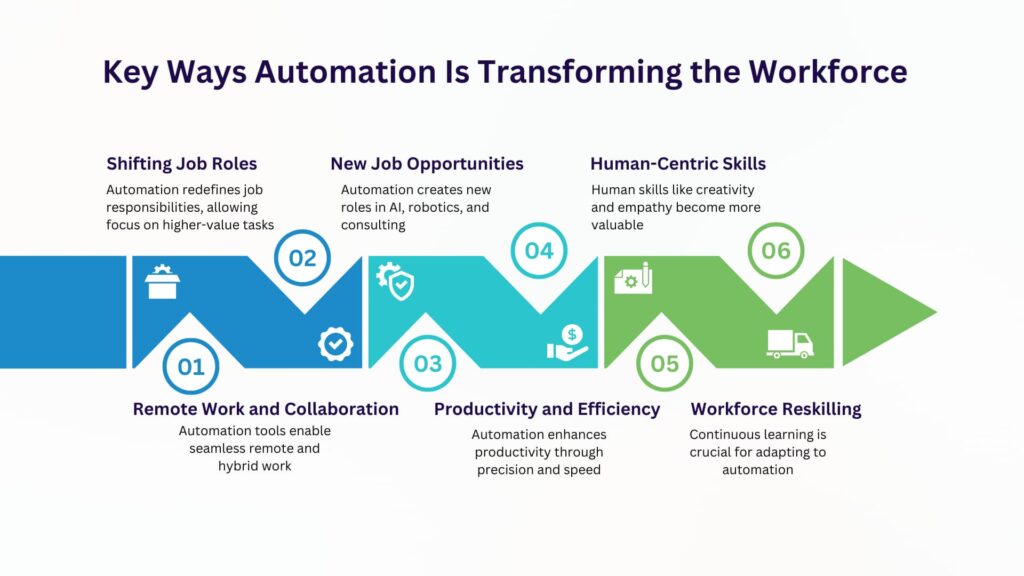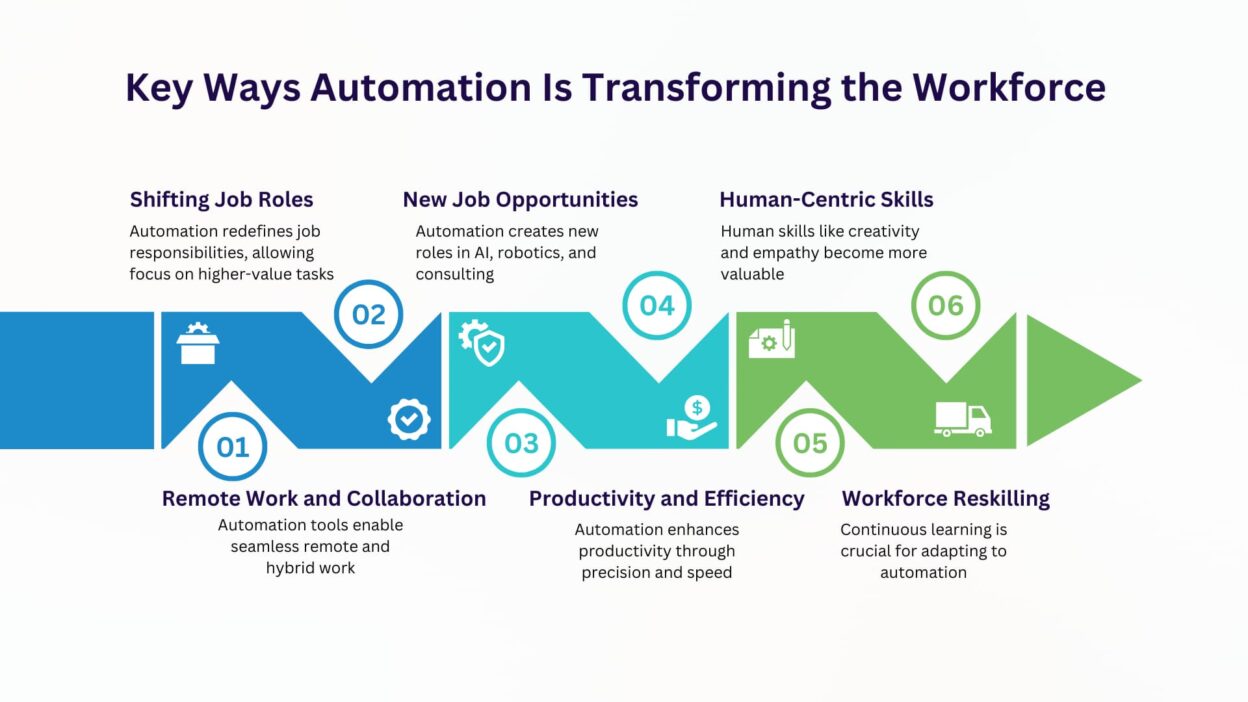Automation is no longer just a buzzword—it’s a reality reshaping the way businesses operate and how people work. From smart chatbots handling customer service inquiries to robotic arms assembling products in factories, automation is steadily transforming the workforce. The rise of Artificial Intelligence (AI), machine learning, and robotics is not only improving efficiency but also redefining roles, skill requirements, and even career paths.
In this article, we’ll explore how automation is driving workforce transformation, what it means for employees and employers, and how to prepare for this rapidly changing future.
Understanding Workforce Automation
At its core, workforce automation is the use of technology to perform tasks that were traditionally done by humans. This includes:
- Process automation (e.g., using software bots to handle repetitive tasks like data entry).
- Industrial automation (e.g., robots assembling cars or packaging goods).
- Intelligent automation (e.g., AI tools analyzing large datasets and making predictions).
Why Automation Matters Today
Automation has existed for decades, but several factors make it more relevant than ever:
- Rapid technological advancements – AI, robotics, and IoT are becoming smarter and more accessible.
- Global competition – Companies are adopting automation to reduce costs and stay competitive.
- Workforce shortages – Many industries face talent gaps that automation helps fill.
- Changing consumer expectations – Customers expect speed, personalization, and efficiency.
Key Ways Automation Is Transforming the Workforce

1. Shifting Job Roles and Responsibilities
Automation is taking over repetitive and rule-based tasks, which frees employees to focus on higher-value work. For example:
- In finance, software bots can process invoices, while humans focus on financial strategy.
- In healthcare, AI can analyze medical scans, while doctors focus on patient care.
- In customer service, chatbots answer FAQs, while agents handle complex cases.
2. Creation of New Job Opportunities
While some worry about job losses, automation also sparks the creation of entirely new roles. Some of the fastest-growing careers today didn’t exist a decade ago. Examples include:
- AI trainers who teach algorithms how to recognize patterns.
- Robotics maintenance technicians who keep machines running smoothly.
- Automation consultants who design strategies for businesses adopting new tech.
3. Greater Focus on Human-Centric Skills
As machines take over repetitive work, human skills such as creativity, leadership, empathy, and critical thinking become more valuable. Companies now look for employees who can:
- Adapt quickly to new tools.
- Solve complex, non-linear problems.
- Communicate effectively across teams.
- Provide emotional intelligence in areas where automation falls short.
4. Remote Work and Digital Collaboration
Automation tools also play a huge role in enabling remote and hybrid work. Cloud-based project management software, automated scheduling tools, and AI-powered communication apps make collaboration seamless.
For instance, automation can:
- Assign tasks automatically based on team availability.
- Generate meeting notes and action points with AI transcription.
- Provide real-time analytics on project progress.
5. Improved Productivity and Efficiency
One of the most obvious impacts of automation is improved productivity. Machines don’t tire, don’t need breaks, and can handle tasks with precision. This leads to:
- Faster production cycles in manufacturing.
- Streamlined operations in logistics and supply chains.
- Better decision-making through real-time data insights.
6. Workforce Reskilling and Upskilling
Perhaps the biggest transformation lies in continuous learning. To thrive in the age of automation, employees must regularly upgrade their skills. Companies are investing in:
- Upskilling programs – teaching employees how to use new tools.
- Reskilling initiatives – preparing workers for entirely new roles.
- Online learning platforms – offering flexible, on-demand training.
The Benefits of Workforce Automation
For Businesses:
- Cost savings through efficiency.
- Improved accuracy and reduced human error.
- Ability to scale operations faster.
- Access to better business insights.
For Employees:
- Freedom from repetitive tasks.
- Opportunities to learn new, valuable skills.
- More engaging, creative roles.
- Increased flexibility through digital tools.
The Challenges of Workforce Automation
Of course, automation also comes with challenges. Some of the most common include:
- Job displacement fears – Workers may feel uncertain about their future.
- Skill gaps – Not all employees have the technical skills required.
- Implementation costs – Businesses may face high upfront investments.
- Resistance to change – Both leaders and employees may hesitate to adopt new systems.
Preparing for the Future of Work
So, how can businesses and employees prepare for this workforce transformation?
For Businesses:
- Invest in automation gradually, focusing on areas that bring clear ROI.
- Provide training and development opportunities for employees.
- Build a culture of collaboration between humans and technology.
- Stay adaptable to future innovations.
For Employees:
- Develop technical literacy (learn the basics of AI, data, and automation tools).
- Strengthen soft skills like communication, leadership, and adaptability.
- Embrace lifelong learning through online courses and certifications.
- Look for opportunities to work alongside automation rather than avoid it.
Real-World Examples of Automation in Action
- Retail: Self-checkout kiosks and AI-driven recommendation engines are reshaping shopping experiences.
- Healthcare: AI-powered diagnostic tools help doctors detect diseases earlier.
- Logistics: Automated warehouses use robotics to speed up order fulfillment.
- Banking: Chatbots and robotic process automation (RPA) streamline customer support and loan processing.
Final Thoughts
Automation is transforming the workforce at an unprecedented pace. Far from eliminating human work, it’s shifting focus toward skills and roles that require creativity, critical thinking, and emotional intelligence. Businesses that embrace this change and invest in their people will not only stay competitive but also build a workforce ready for the future.
The message is clear: automation is not about replacing humans—it’s about empowering them.
By approaching automation with the right mindset, we can create a world where technology handles the repetitive, freeing humans to do what they do best—innovate, connect, and lead.



